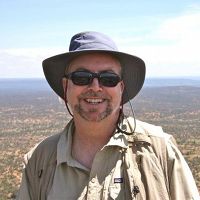Chorover et al., 2013
Fluid Chemistry Dynamics Before and After Fire in the Jemez River Basin Critical Zone Observatory
Chorover J., Perdrial J.N., Field J.P., Pelletier J.D., Pohlmann M.A., Losleben M.V., Lasharr K., Amistadi M., Brooks P.D., McIntosh J.C., Meixner T., Gallery R., Rich V.I., Rasmussen C., Schaap M.G., Breshears D.D. (2013)
Abstract B41F-05 presented at 2013 Fall Meeting, AGU, San Francisco, CA, 9-13 Dec.
-
Catalina-Jemez, INVESTIGATOR
-
Catalina-Jemez, Luquillo, Reynolds, INVESTIGATOR
-
Catalina-Jemez, INVESTIGATOR
-
Catalina-Jemez, INVESTIGATOR
-
Catalina-Jemez, GRAD STUDENT
-
Catalina-Jemez, STAFF
-
Catalina-Jemez, INVESTIGATOR
-
Catalina-Jemez, INVESTIGATOR
-
Catalina-Jemez, INVESTIGATOR
-
Catalina-Jemez, INVESTIGATOR
-
Catalina-Jemez, INVESTIGATOR
-
Catalina-Jemez, INVESTIGATOR
Abstract
The largest wildfire in New Mexico state history (prior to the Whitewater-Baldy fire of 2012) burned the eastern portion of the Jemez River Basin Critical Zone Observatory (JRB CZO) in June-July 2011. This Los Conchas fire burned large stands of ponderosa pine and mixed conifer (MC) forest within the East Fork Jemez River watershed generating massive post-fire erosion. We asked the question: What are the implications of wildfire on pulsed carbon and other bio-active element redistributions in impacted soils and catchments? As soon as possible following the fire, our research group installed sensor and sampler instrumentation in soil profiles in an intensively burned zero order basin (ZOB), enabling the initiation of comparisons to a similarly instrumented, unburned MC ZOB. The signal of biomass combustion was propagated through soil and stream. Post-burn solute fluxes were dominated by highly-aromatic character DOM, as well as elevated DIC, sulfate, chloride and non-hydrolyzing cation (Ca, Mg, K) concentrations deriving from biomass combustion. Supporting an apparent trend of increasing wildfire in western montane forests, the Thompson Ridge wildfire burned MC forest throughout much of the western previously unburned portion of the Valles Caldera National Preserve in June 2013, including the (until then) "unburned" MC ZOB sites comprising CZO sensor and sampler network arrays. Post-burn soil samples were collected for geochemical, physical, and microbial composition characterizations. Solute and gas fluxes were monitored in situ to compare CZ response following this high intensity burn to three years of pre-burn data. Results indicate that the post-fire pulse of water soluble, biomass-derived ions and carbon into underlying and downslope soils is generating landscape-scale element distribution that could affect recolonization by biota in the ensuing secondary succession.
URL: /jemez-catalina/
Citation
Chorover J., Perdrial J.N., Field J.P., Pelletier J.D., Pohlmann M.A., Losleben M.V., Lasharr K., Amistadi M., Brooks P.D., McIntosh J.C., Meixner T., Gallery R., Rich V.I., Rasmussen C., Schaap M.G., Breshears D.D. (2013): Fluid Chemistry Dynamics Before and After Fire in the Jemez River Basin Critical Zone Observatory. Abstract B41F-05 presented at 2013 Fall Meeting, AGU, San Francisco, CA, 9-13 Dec..
 This Paper/Book acknowledges NSF CZO grant support.
This Paper/Book acknowledges NSF CZO grant support.
Explore Further













